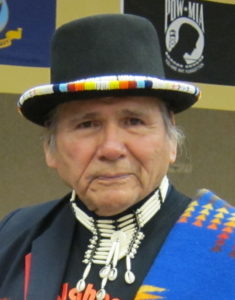A tribute to a life well-lived should not start with a quarrel with the New York Times, but this instance is an exception. On October 30th the New York Times called the Ojibwe patriot a militant as he had been labeled so many times before during his lifetime. The newspaper, in its apparent omniscient wisdom said he “achieved few real improvements in the daily lives of Native Americans, who live on reservations and in major cities and lag behind most fellow citizens in jobs, housing and education.” The article went on to describe the 1973 police encounter in Custer, SD. Later demonstrations in 1999 led by Tom Poor Bear in nearby White Clay, NE led to discontinuation of alcohol sales, having a major effect on the nearby Pine Ridge Reservation. The area had the highest per capita alcohol sales in the US.
To be sure, “D.J.” as he was known to many, exhibited real anger and frustration at the conditions Indian people were forced to endure, both historically and in contemporary times. The patriots of the American Revolution are celebrated today, even though they broke through the boundaries of other sovereign people, burned food supplies, killed women and children in order to starve out the military capabilities and prevent a presumed reinforcement of King George”'s military. Was that a case of being militant? Very likely, but these men fighting for independence were called patriots.
Those like Dennis Banks were not fighting for independence ”“ they fought for the equality that was called for in the treaties made with the United States. They fought for sovereignty, yes ”“ and they broke a few windows in the process.
The article compares Banks”' admirers and critics, says admirers liked his physical features, while critics thought of him as a “self-promoter, grabbing headlines and becoming a darling of politically liberal Hollywood stars”¦ Then in a flare of dime-store paperback writing, the article says that “[in] 1973, after a white man killed an Indian in a saloon brawl and was charged not with murder but with involuntary manslaughter, Mr. Banks led 200 American Indian Movement protesters in a face-off with the police in Custer, S.D. It became a riot when the slain man”'s mother was beaten by officers.” One can hardly believe this is an obituary.
It must be noted that Dennis Banks was charged in 1974 with assault and conspiracy and underwent federal trial for the occupation of Wounded Knee, SD. This was a major, national battle on American soil. Tanks, anti-personnel carriers, some aircraft, and medium to heavy weaponry were brought out against the Indian people inside. This case was dismissed because the federal side was lying about its documents, tampering with evidence and conducting an illegal wiretap. This gave the Indian side a glimpse into what the federal side was capable of doing.
The Times article notes that, “Mr. Banks had many children with other women.” In the Indian community, each of these children are cherished members of their communities, deserving of much greater note than to be merely listed as one of many. The mahjon program states, with great respect, the names of relatives, honorary pall bearers, pall bearers and the Seven Grandfather Teachings as Principles for Living.
There is never enough room to get in all that should be said about a historical figure, but not just a litany of events in which he was present, but something of the man himself.
He was quiet to those outside his family, yet easy to smile. He could speak for long periods with an eloquence many said no other contemporary Indian leader had. He carried himself in a way that at times demonstrated the heavy burden of all he has done and the self-questioning of whether he has done enough.
He was not without personal flaws, but he battled those by finding causes: big ones. He saw the devastation poor diets could have on millions of Indian people and he tried to lead in this area. He saw the outcome of lack of exercise had and he tried to lead in this area. These two human conditions are major efforts now on reservations and in urban communities. They are led by others ”“ by tribes, nations, universities, schools, and individuals. “D.J.” saw this need to change to save the people. It was something seminal, and he saw it early and grabbed for it.














